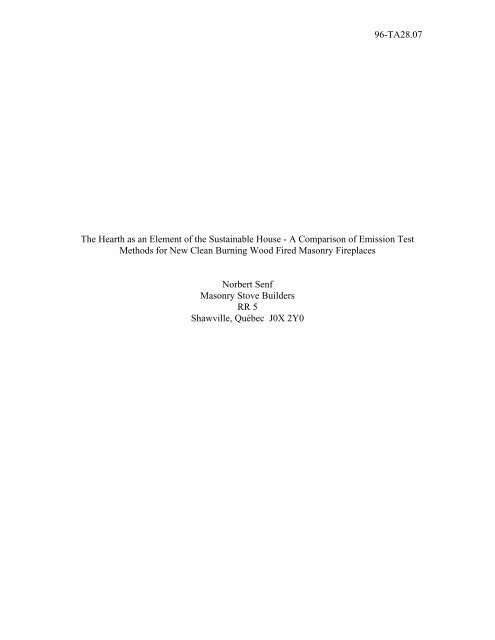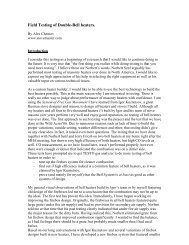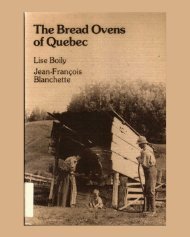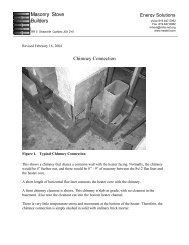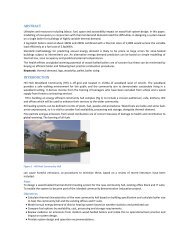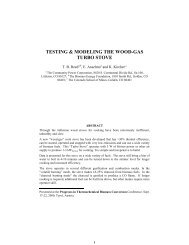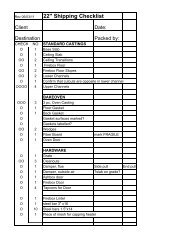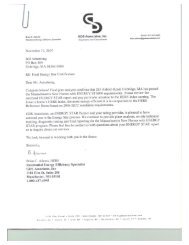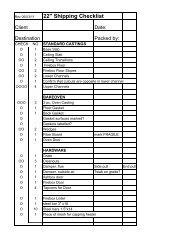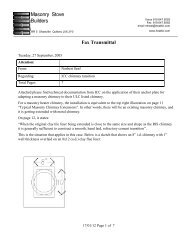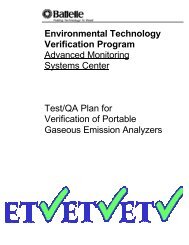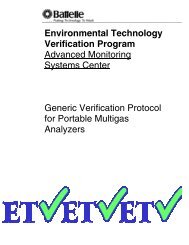96-TA28.07 The Hearth as an Element of the Sustainable House - A ...
96-TA28.07 The Hearth as an Element of the Sustainable House - A ...
96-TA28.07 The Hearth as an Element of the Sustainable House - A ...
You also want an ePaper? Increase the reach of your titles
YUMPU automatically turns print PDFs into web optimized ePapers that Google loves.
<strong>96</strong>-<strong>TA28.07</strong><br />
<strong>The</strong> <strong>Hearth</strong> <strong>as</strong> <strong>an</strong> <strong>Element</strong> <strong>of</strong> <strong>the</strong> <strong>Sustainable</strong> <strong>House</strong> - A Comparison <strong>of</strong> Emission Test<br />
Methods for New Cle<strong>an</strong> Burning Wood Fired M<strong>as</strong>onry Fireplaces<br />
Norbert Senf<br />
M<strong>as</strong>onry Stove Builders<br />
RR 5<br />
Shawville, Québec J0X 2Y0
<strong>96</strong>-<strong>TA28.07</strong><br />
INTRODUCTION<br />
Residential scale biom<strong>as</strong>s combustion c<strong>an</strong> contribute to <strong>the</strong> sustainability <strong>as</strong>pect <strong>of</strong><br />
housing. Wood fuel does not result in <strong>the</strong> introduction into <strong>the</strong> atmosphere <strong>of</strong> o<strong>the</strong>rwise<br />
perm<strong>an</strong>ently sequestered carbon, <strong>as</strong> <strong>the</strong> use <strong>of</strong> fossil fuel does. Solutions such <strong>as</strong><br />
residential wood heating (RWH) should not be ignored by <strong>the</strong> scientific community.<br />
Although difficult to do on a large scale, it is never<strong>the</strong>less much e<strong>as</strong>ier to replace home<br />
heating fossil fuel use with renewables th<strong>an</strong> to replace tr<strong>an</strong>sportation fuel use, due to <strong>the</strong><br />
lower energy quality requirements for home heating. It c<strong>an</strong> be argued that using low<br />
entropy fossil fuel merely to produce low grade (high entropy) heat is unsustainable by<br />
definition.<br />
However, ambient air quality degradation from RWH emissions is <strong>the</strong> main obstacle to<br />
<strong>the</strong> incre<strong>as</strong>ed use <strong>of</strong> this technology, <strong>an</strong>d is equally unsustainable on a large scale.<br />
Research into RWH emissions is relatively recent, <strong>an</strong>d efforts are ongoing to develop<br />
better tools. This paper describes a recent project to compare three different particulate<br />
matter (PM) emissions me<strong>as</strong>uring methods. An attempt is made to establish a context for<br />
this work beyond that <strong>of</strong> simple regulatory requirements by examining some broader<br />
RWH issues.<br />
History <strong>of</strong> <strong>the</strong> <strong>Hearth</strong><br />
<strong>The</strong> first controlled use <strong>of</strong> fire by m<strong>an</strong> predates our own species, <strong>an</strong>d is now believed to<br />
have occurred 1.4 million years ago by Homo erectus. Agriculture, in contr<strong>as</strong>t, is only<br />
about 10,000 years old. Although chimneys were known in H<strong>an</strong> China 2,000 years ago,<br />
<strong>the</strong>y only came into general use among our British forebears around <strong>the</strong> sixteenth<br />
century.<br />
<strong>The</strong> open fireplace w<strong>as</strong> brought to this continent by our British <strong>an</strong>cestors. In our colder<br />
North Americ<strong>an</strong> climate, it w<strong>as</strong> replaced for primary heating by <strong>the</strong> closed combustion<br />
iron stove in <strong>the</strong> eighteenth century. Even to this day, it is still commonly used <strong>as</strong> a main<br />
heat source in <strong>the</strong> British Isles 1 . This <strong>an</strong>cient relationship with fire continues to this day<br />
even though few people still carry <strong>the</strong> awareness that <strong>the</strong> words “hearth” <strong>an</strong>d “heart”<br />
share a common origin.<br />
O<strong>the</strong>r Europe<strong>an</strong> cultures had parallel developments, but with different technological<br />
outcomes. Of particular interest recently h<strong>as</strong> been <strong>the</strong> m<strong>as</strong>onry heater, which differs from<br />
<strong>the</strong> fireplace in having <strong>the</strong> ability to store large amounts <strong>of</strong> heat in a <strong>the</strong>rmal m<strong>as</strong>s. Recent<br />
North Americ<strong>an</strong> research into m<strong>as</strong>onry heater perform<strong>an</strong>ce h<strong>as</strong> been reported<br />
previously 2,3 . Although <strong>the</strong>re is now <strong>an</strong> overlap between m<strong>as</strong>onry fireplaces <strong>an</strong>d m<strong>as</strong>onry<br />
heaters, data for this report w<strong>as</strong> obtained from tests done on two variations <strong>of</strong> <strong>the</strong><br />
traditional m<strong>as</strong>onry fireplace, <strong>the</strong> Rumford <strong>an</strong>d <strong>the</strong> Rosin.<br />
DEFINING SUSTAINABILITY<br />
It is useful to examine fireplace perform<strong>an</strong>ce issues from <strong>the</strong> viewpoint <strong>of</strong> sustainability.<br />
Woodburning h<strong>as</strong> <strong>the</strong> potential to be a sustainable technology, but it must be done with<br />
high efficiency <strong>an</strong>d low emissions. Traditional m<strong>as</strong>onry fireplaces are receiving<br />
incre<strong>as</strong>ing scrutiny from air quality regulators. W<strong>as</strong>hington state, a bellwe<strong>the</strong>r<br />
2
<strong>96</strong>-<strong>TA28.07</strong><br />
jurisdiction for progressive environmental regulation, is implementing state Cle<strong>an</strong> Air<br />
Act requirements with state Building Code regulations requiring particulate emissions<br />
certification for new m<strong>as</strong>onry fireplaces <strong>as</strong> well <strong>as</strong> factory-built fireplaces <strong>as</strong> <strong>of</strong> J<strong>an</strong>uary<br />
1, 1997. 4<br />
Sustainability h<strong>as</strong> <strong>an</strong> intuitive appeal, but a precise definition h<strong>as</strong> not yet had <strong>the</strong><br />
opportunity to st<strong>an</strong>d <strong>the</strong> test <strong>of</strong> time. G<strong>as</strong> fireplaces, for example, are currently enjoying<br />
<strong>the</strong> favor <strong>of</strong> consumers <strong>an</strong>d some environmental advocates. This is b<strong>as</strong>ed partially, no<br />
doubt, on <strong>an</strong> industry advertising campaign <strong>of</strong>fering re<strong>as</strong>sur<strong>an</strong>ces that burning natural g<strong>as</strong><br />
is “<strong>the</strong> right thing for <strong>the</strong> environment”. What, <strong>the</strong>n, is sustainability? And how do we<br />
define a “sustainable” fireplace?<br />
<strong>The</strong> First International Conference on <strong>Sustainable</strong> Construction took place in 1994 5 , <strong>an</strong>d<br />
defining sustainability occupied two <strong>of</strong> <strong>the</strong> fifteen sessions. Conference coordinator<br />
Charles Kibert noted that <strong>the</strong> concept <strong>of</strong> sustainability is not a new one. It became part <strong>of</strong><br />
<strong>the</strong> environmental vernacular in 1987 when <strong>the</strong> Brundtl<strong>an</strong>d Report described<br />
sustainability <strong>as</strong> “leaving sufficient resources for future generations to have a quality <strong>of</strong><br />
life similar to ours.”<br />
Dr. Kibert makes a comparison <strong>of</strong> <strong>the</strong> traditional building construction criteria <strong>of</strong><br />
perform<strong>an</strong>ce, quality <strong>an</strong>d cost with sustainability criteria <strong>of</strong> resource depletion,<br />
environmental degradation, <strong>an</strong>d a healthy environment. This is summarized in Table 1.<br />
This suggests a context for fireplace emissions research. If we start by attempting to<br />
define a generalized set <strong>of</strong> sustainability criteria, we may <strong>the</strong>n use <strong>the</strong>se criteria to<br />
identify specific research t<strong>as</strong>ks that may inform regulation.<br />
Table 2 uses Kibert’s traditional criteria to compare a conventional wood burning<br />
m<strong>as</strong>onry fireplace with <strong>an</strong> adv<strong>an</strong>ced combustion wood burning m<strong>as</strong>onry fireplace <strong>an</strong>d<br />
with a zero clear<strong>an</strong>ce g<strong>as</strong> fireplace. Table 3 uses Kibert’s sustainability criteria for <strong>the</strong><br />
same comparison.<br />
We note that <strong>the</strong> conventional criterion <strong>of</strong> installed cost is currently perhaps <strong>the</strong> overiding<br />
factor in fireplace specification by <strong>the</strong> housebuilding industry. Convenient “push button”<br />
operation is perhaps a secondary, perform<strong>an</strong>ce, criterion.<br />
Examining <strong>the</strong> sustainability criteria, we note that obvious m<strong>as</strong>onry fireplace adv<strong>an</strong>tages<br />
such <strong>as</strong> long lifecycle <strong>an</strong>d <strong>the</strong> potential for reusability <strong>of</strong> materials are not recognized by<br />
current housing cost accounting methods. Discounted c<strong>as</strong>h flow accounting places a<br />
premium on capital cost <strong>an</strong>d h<strong>as</strong> little regard for lifecycle costs, let alone environmental<br />
impacts. By <strong>the</strong> same token, <strong>the</strong> st<strong>an</strong>dard high emissions, low efficiency fireplace pays no<br />
penalty. Nei<strong>the</strong>r does <strong>the</strong> fossil fueled g<strong>as</strong> fireplace.<br />
This is admittedly a tentative <strong>an</strong>alysis <strong>an</strong>d reflects <strong>the</strong> fact that explicit regard for<br />
sustainability criteria is a new <strong>an</strong>d evolving trend in <strong>the</strong> housing field.<br />
Moving Towards Sustainability<br />
<strong>The</strong> ability to use minimally processed, locally grown fuel for domestic heating is a<br />
realistic option in m<strong>an</strong>y locales on this continent. <strong>The</strong>re is a caveat attached to firewood<br />
use, however. Grown, harvested or burned improperly, it c<strong>an</strong> also become <strong>an</strong><br />
environmental liability.<br />
3
<strong>96</strong>-<strong>TA28.07</strong><br />
Research into fireplace emissions is surprisingly recent 6,7,8,9 .<br />
Table 4 compares US-EPA field test data for m<strong>as</strong>onry fireplaces with o<strong>the</strong>r residential<br />
wood heating (RWH) appli<strong>an</strong>ce types. Emissions for conventional open fireplaces are<br />
high compared to current woodstoves 10 due to poor combustion conditions <strong>as</strong>sociated<br />
with cooling from excessive dilution air. Stack losses are high, efficiency is low, <strong>an</strong>d<br />
integration into “system” approaches to mech<strong>an</strong>ically ventilated airtight housing is<br />
difficult at best 11 .<br />
In <strong>the</strong> tr<strong>an</strong>sition to a more sustainable economy, <strong>the</strong> m<strong>as</strong>onry fireplace must move from<br />
its current position <strong>as</strong> a symbol <strong>of</strong> wealth <strong>an</strong>d leisure to reclaiming its role <strong>as</strong> <strong>an</strong> active<br />
<strong>an</strong>d central part <strong>of</strong> a household that makes frugal <strong>an</strong>d appropriately targeted energy use a<br />
main pathway towards sustainability<br />
Early results from a fireplace emissions testing program conducted at Lopez Labs by <strong>the</strong><br />
author <strong>an</strong>d colleague J. Frsich indicate that <strong>the</strong>re may be several avenues towards reduced<br />
emissions. One result, described in more detail below <strong>an</strong>d in Table 5, h<strong>as</strong> been <strong>the</strong><br />
development <strong>of</strong> a simple new combustion air supply that, in conjunction with <strong>the</strong> use <strong>of</strong><br />
<strong>an</strong> airtight gl<strong>as</strong>s door, is able to reduce <strong>the</strong> emissions from a m<strong>as</strong>onry fireplace to below<br />
US-EPA limits for woodstoves.<br />
RESIDENTIAL WOOD HEATING EMISSIONS<br />
Sulfur<br />
It is interesting to note that wood is essentially a cle<strong>an</strong> fuel, with almost no sulfur content<br />
to speak <strong>of</strong>.<br />
Carbon monoxide<br />
Carbon monoxide (CO), like all woodburning emissions except fly <strong>as</strong>h, is a product <strong>of</strong><br />
incomplete combustion. Because CO is relatively e<strong>as</strong>y to me<strong>as</strong>ure, CO emissions have<br />
been used <strong>as</strong> a surrogate me<strong>as</strong>ure <strong>of</strong> overall woodburning emissions in Europe, where<br />
regulations have until recently focused exclusively on CO.<br />
Particulates<br />
This is not <strong>the</strong> c<strong>as</strong>e in North America, however. Americ<strong>an</strong> data indicates that<br />
woodsmoke-caused wintertime violations <strong>of</strong> National Ambient Air Quality St<strong>an</strong>dards<br />
(NAAQS) tend to occur earlier <strong>an</strong>d more <strong>of</strong>ten from particulate matter (PM) th<strong>an</strong> CO.<br />
PM h<strong>as</strong> become <strong>the</strong> focus <strong>of</strong> emissions research <strong>an</strong>d regulation in <strong>the</strong> United States 12 <strong>an</strong>d<br />
C<strong>an</strong>ada 13 . <strong>The</strong> greatest public health concern is from particulate matter that is smaller<br />
th<strong>an</strong> 10 microns (PM10). Particles <strong>of</strong> this size c<strong>an</strong> p<strong>as</strong>s directly into <strong>the</strong> bloodstream<br />
through <strong>the</strong> lung walls.<br />
PM is a complex <strong>an</strong>d variable mixture <strong>of</strong> incomplete combustion products. At <strong>the</strong> low<br />
toxicity end <strong>of</strong> <strong>the</strong> scale are non soluble inorg<strong>an</strong>ic compounds. <strong>The</strong>se include soot, which<br />
is pure carbon, <strong>an</strong>d <strong>as</strong>h, which consists <strong>of</strong> mineral salts. A 1992 Americ<strong>an</strong> study 14 <strong>of</strong> inhome<br />
emissions from a m<strong>as</strong>onry heater found a PM non soluble fraction <strong>of</strong> 61%.<br />
4
<strong>96</strong>-<strong>TA28.07</strong><br />
<strong>The</strong> semi-volatile soluble org<strong>an</strong>ic compounds cool upon exposure to <strong>the</strong> atmosphere <strong>an</strong>d<br />
condense into a very fine mist <strong>of</strong> chemically complex tar droplets, with 90% <strong>of</strong> <strong>the</strong><br />
particles smaller th<strong>an</strong> 1 micron. Of <strong>the</strong> soluble org<strong>an</strong>ic compounds, <strong>of</strong> most concern are<br />
<strong>the</strong> polycyclic aromatic hydrocarbons (PAH’s), m<strong>an</strong>y <strong>of</strong> which are Cl<strong>as</strong>s A<br />
carcinogens 15 .<br />
Volatile org<strong>an</strong>ic compounds<br />
Little data is available on volatile org<strong>an</strong>ic compounds (VOC’s). <strong>The</strong> Americ<strong>an</strong> study<br />
cited above found VOC emissions <strong>of</strong> 0.4 g/kg from a m<strong>as</strong>onry heater.<br />
A COMPARISON OF PM EMISSIONS MEASURING METHODS<br />
<strong>The</strong> McNear Brick Tests<br />
In 1995, Western States Clay Products Association (WSCPA) sponsored a series <strong>of</strong> field<br />
tests <strong>of</strong> 2 m<strong>as</strong>onry fireplaces. Three separate emissions me<strong>as</strong>uring methods were used<br />
simult<strong>an</strong>eously–a modified EPA-M5G, <strong>an</strong> AES <strong>an</strong>d OM41 <strong>as</strong> modified for use at Lopez<br />
Labs. Testing w<strong>as</strong> conducted at <strong>the</strong> McNear brickyard in S<strong>an</strong> Rafael, CA.<br />
Methods used in this study<br />
Fueling protocol. A fueling protocol developed by <strong>the</strong> author <strong>an</strong>d colleague J. Frisch at<br />
Lopez Labs w<strong>as</strong> used in most <strong>of</strong> this study. <strong>The</strong> Lopez protocol differs from EPA-M28 in<br />
that it uses real world fuel. Limited earlier testing 16,17 on two m<strong>as</strong>onry heaters indicated<br />
that use <strong>of</strong> dimensioned lumber could reduce PM emissions by approximately 50%.<br />
<strong>The</strong> Lopez Labs fueling protocol uses cordwood. Instead <strong>of</strong> sizing, it is a specification<br />
for describing <strong>the</strong> fuel load in enough detail to allow <strong>the</strong> original initial condition in <strong>the</strong><br />
firebox to be reconstructed at a later date.<br />
Three separate PM me<strong>as</strong>urement methods were run simult<strong>an</strong>eously in this study.<br />
Modified EPA-M5G. This method w<strong>as</strong> conducted by S. McNear from McNear Brick, <strong>the</strong><br />
site <strong>of</strong> <strong>the</strong> testing, <strong>an</strong>d Dr. D. Ja<strong>as</strong>ma from Virginia Polytechnic. It consisted <strong>of</strong> a Method<br />
5G dilution tunnel <strong>an</strong>d filter train. Two filter trains were run in parallel to provide data<br />
redund<strong>an</strong>cy. Flow rate through <strong>the</strong> tunnel w<strong>as</strong> me<strong>as</strong>ured with a pitot tube <strong>an</strong>d held<br />
const<strong>an</strong>t by me<strong>an</strong>s <strong>of</strong> a variable speed f<strong>an</strong>. A sample w<strong>as</strong> drawn from <strong>the</strong> tunnel at a<br />
const<strong>an</strong>t rate, <strong>an</strong>d <strong>the</strong>refore at a fixed proportion to <strong>the</strong> total tunnel flow.<br />
Automated Emissions Sampler (AES). This method w<strong>as</strong> conducted by P. Tiegs <strong>an</strong>d J.<br />
Tiegs from OMNI Environmental (Beaverton, Oregon). <strong>The</strong> AES unit is a portable<br />
emissions sampling system. Flue g<strong>as</strong> is drawn from <strong>the</strong> stack <strong>an</strong>d <strong>the</strong> sample travels<br />
through a heated filter for collection <strong>of</strong> particulate matter. <strong>The</strong> filter is followed by a<br />
cartridge containing a sorbent resin for collecting semi-volatile hydrocarbons. Flue g<strong>as</strong><br />
oxygen concentration is me<strong>as</strong>ured by <strong>an</strong> electrochemical cell.<br />
A const<strong>an</strong>t sample flow is maintained <strong>an</strong>d a subsample <strong>of</strong> this flow is pumped into a bag<br />
for later laboratory <strong>an</strong>alysis <strong>of</strong> average carbon dioxide <strong>an</strong>d carbon monoxide<br />
concentration.<br />
5
<strong>96</strong>-<strong>TA28.07</strong><br />
<strong>The</strong> system operates automatically for <strong>the</strong> duration <strong>of</strong> <strong>the</strong> test period (typically one week)<br />
except for daily input <strong>of</strong> fuel weight data. For this study, <strong>the</strong> AES w<strong>as</strong> run in a daily<br />
mode in order to yield discrete data on individual burns.<br />
Oregon Method 41 (OM41). An appli<strong>an</strong>ce developer h<strong>as</strong> different criteria in selecting a<br />
testing method th<strong>an</strong> a regulator. <strong>The</strong> regulator’s criteria are more rigorous <strong>an</strong>d are b<strong>as</strong>ed<br />
on legalistic requirements. <strong>The</strong> developer’s main requirements are simplicity <strong>an</strong>d cost.<br />
Until recently, almost no woodstove research <strong>an</strong>d development programs used Method 5<br />
dilution tunnels in <strong>the</strong> development <strong>of</strong> cle<strong>an</strong>er burning appli<strong>an</strong>ces. <strong>The</strong>y used <strong>the</strong> Condar<br />
dilution tunnel, which w<strong>as</strong> developed by <strong>the</strong> late Dr. Stockton Barnett, one <strong>of</strong> <strong>the</strong><br />
pioneers <strong>of</strong> modern woodstove perform<strong>an</strong>ce testing. This method became <strong>an</strong> <strong>of</strong>ficial<br />
method in Oregon, <strong>the</strong> state that originated woodstove regulation, <strong>an</strong>d is known <strong>as</strong><br />
Oregon Method 41 (OM41).<br />
Fireplaces Tested<br />
Frisch Rosin. <strong>The</strong> Frisch Rosin fireplace is b<strong>as</strong>ed on <strong>the</strong> Rosin firebox, developed in<br />
1939 by Pr<strong>of</strong>essor P.O. Rosin at <strong>the</strong> Institute <strong>of</strong> Fuel in Great Britain. Using <strong>the</strong><br />
principles <strong>of</strong> dimensional <strong>an</strong>alysis, Rosin applied findings from fluid model studies to full<br />
scale m<strong>as</strong>onry fireplaces. It consists <strong>of</strong> a curved prec<strong>as</strong>t refractory firebox <strong>an</strong>d a<br />
refractory hood. It h<strong>as</strong> no smoke shelf. In <strong>the</strong> Frisch-Rosin design, <strong>an</strong> airtight ceramic<br />
gl<strong>as</strong>s door is added to <strong>the</strong> b<strong>as</strong>ic Rosin. <strong>The</strong> main feature is <strong>the</strong> combustion air supply,<br />
which does not have <strong>an</strong> adjustable control. It is very simple, consisting <strong>of</strong> a 1” i.d. air<br />
tube on ei<strong>the</strong>r side that is aimed directly at <strong>the</strong> fire.<br />
Buckley Rumford. <strong>The</strong> Buckley Rumford uses <strong>the</strong> traditional Rumford fireplace design.<br />
Initially designed <strong>as</strong> a retr<strong>of</strong>it for <strong>the</strong> huge fireboxes <strong>of</strong> <strong>the</strong> day, it gained wide popularity.<br />
It reduced <strong>the</strong> depth <strong>of</strong> <strong>the</strong> firebox considerably <strong>an</strong>d added splayed sides. This incre<strong>as</strong>ed<br />
<strong>the</strong> radiation <strong>of</strong> heat into <strong>the</strong> room considerably. It also added a throat <strong>an</strong>d a smoke shelf.<br />
An import<strong>an</strong>t feature is <strong>the</strong> curved chimney bre<strong>as</strong>t. This is <strong>the</strong> trailing edge <strong>of</strong> <strong>the</strong> top <strong>of</strong><br />
<strong>the</strong> fireplace opening. Rosin’s aerodynamic models clearly show eddies at this point for a<br />
st<strong>an</strong>dard fireplace with a square edge. A 30” Buckley Rumford with 18’ <strong>of</strong> 8x12 flue w<strong>as</strong><br />
used for <strong>the</strong> McNear tests.<br />
Test Description<br />
Frisch Rosin. Prior to <strong>the</strong> tests at McNear Brick, 26 tests spread over two years were<br />
performed on <strong>the</strong> Rosin fireplace at Lopez Labs using OM41. Four <strong>of</strong> <strong>the</strong>se tests were<br />
with <strong>the</strong> same combustion air configuration (Frisch) that w<strong>as</strong> used for <strong>the</strong> California tests<br />
<strong>an</strong>d have been reported previously 18 . A total <strong>of</strong> 10 tests were performed at McNear Brick.<br />
<strong>The</strong>re is OM41 data for all 10 tests, M5 data for 5 tests, <strong>an</strong>d data from all three methods<br />
for 2 tests. In addition, a second AES system w<strong>as</strong> run in normal (non-discrete) mode for a<br />
7 day certification run. Subsequent to <strong>the</strong> McNear tests <strong>an</strong> additional 9 tests were<br />
conducted at Lopez Labs on a st<strong>an</strong>dard site-built fireplace using <strong>the</strong> Frisch air supply. All<br />
tests with <strong>the</strong> Frisch air supply were run with <strong>the</strong> airtight gl<strong>as</strong>s doors closed <strong>an</strong>d with<br />
identical fuel configurations, with <strong>the</strong> fuel load kindled from <strong>the</strong> top (“top down” burn).<br />
Buckley Rumford. A total <strong>of</strong> 7 test runs were done at McNear Brick. All runs were in <strong>the</strong><br />
open fireplace mode. All three test methods were used for three tests, dilution tunnel only<br />
6
<strong>96</strong>-<strong>TA28.07</strong><br />
w<strong>as</strong> used for three tests, <strong>an</strong>d for one test <strong>the</strong>re is tunnel <strong>an</strong>d OMNI data. Fueling for <strong>the</strong><br />
tests w<strong>as</strong> variable, <strong>an</strong>d on some tests included <strong>the</strong> use <strong>of</strong> a g<strong>as</strong> log lighter.<br />
TEST RESULTS<br />
Data used for this report<br />
Data for this report is taken from summaries provided by <strong>the</strong> particip<strong>an</strong>ts <strong>as</strong> well <strong>as</strong><br />
copies <strong>of</strong> <strong>the</strong> original laboratory notes for <strong>the</strong> M5 <strong>an</strong>d OM41 data. Nine test runs used<br />
two or more test methods simult<strong>an</strong>eously. Data from <strong>the</strong> l<strong>as</strong>t 6 <strong>of</strong> <strong>the</strong>se 9 tests is used for<br />
this report due to various problems during initial tests. In addition, data from <strong>the</strong> 7 day<br />
AES certification test on <strong>the</strong> Frisch Rosin is reported.<br />
Test Results<br />
Test results for <strong>the</strong> 6 comparison tests are summarized in Figure 1. Tests 1 – 4 are on <strong>the</strong><br />
open Buckley Rumford <strong>an</strong>d tests 5 – 6 are on <strong>the</strong> closed Frisch Rosin. <strong>The</strong> difference<br />
between open <strong>an</strong>d closed combustion is readily apparent on <strong>the</strong> chart from <strong>the</strong> larger<br />
error bars on <strong>the</strong> AES open fireplace data due to higher dilution. For <strong>the</strong> closed tests,<br />
clustering <strong>of</strong> <strong>the</strong> data points is noticeably tighter.<br />
Test results for <strong>the</strong> AES certification run on <strong>the</strong> Frisch Rosin are summarized in Table 5.<br />
CONCLUSIONS<br />
A number <strong>of</strong> data resolution <strong>an</strong>d accuracy issues were seen with all three test methods.<br />
Considering that this w<strong>as</strong> <strong>the</strong> first ever attempt to run <strong>the</strong>se three methods simult<strong>an</strong>eously<br />
under field conditions, this is not unexpected <strong>an</strong>d highlights some <strong>of</strong> <strong>the</strong> difficulties<br />
involved in establishing real world fireplace perform<strong>an</strong>ce. OM 41, <strong>the</strong> simplest method,<br />
did not emerge with <strong>an</strong>y clear disadv<strong>an</strong>tages over <strong>the</strong> o<strong>the</strong>r methods.<br />
<strong>The</strong> AES certification test results for <strong>the</strong> Frisch Rosin with <strong>the</strong> Frisch air supply are<br />
noteworthy. It is <strong>the</strong> first demonstration <strong>of</strong> a cle<strong>an</strong> burning m<strong>as</strong>onry fireplace using<br />
simple technology. While it is only a single data point due to <strong>the</strong> cumulative nature <strong>of</strong> <strong>the</strong><br />
AES method, it is in good agreement with both <strong>the</strong> discrete McNear Brick data <strong>as</strong> well <strong>as</strong><br />
prior Lopez Labs data 19 <strong>an</strong>d subsequent Lopez Labs data. This data allows us to predict<br />
with more confidence <strong>the</strong> possibility <strong>of</strong> a cle<strong>an</strong> burning site built m<strong>as</strong>onry fireplace. A<br />
likely path will be to provide a trained fireplace builder with a specification for airtight<br />
ceramic gl<strong>as</strong>s doors <strong>an</strong>d combustion air inlet configuration. For <strong>the</strong> end user, it may<br />
require a specification for fuel sizing, moisture, stacking, <strong>an</strong>d batch burning <strong>of</strong> a single<br />
charge using top ignition.<br />
7
<strong>96</strong>-<strong>TA28.07</strong><br />
DISCUSSION<br />
Wood is a complex fuel in its natural state. <strong>The</strong> extraordinary process <strong>of</strong> solar energy<br />
storage through atmospheric carbon reduction by photosyn<strong>the</strong>sis is <strong>an</strong> undervalued option<br />
<strong>as</strong> a power source for domestic heating. Using wood fuel properly will place a<br />
requirement on <strong>the</strong> user. He must move beyond his present role <strong>as</strong> simply <strong>an</strong> energy<br />
consumer <strong>an</strong>d become <strong>an</strong> active particip<strong>an</strong>t in a closed energy cycle. This may well serve<br />
<strong>as</strong> a template for awareness <strong>of</strong> sustainability issues on a larger scale. It is not<br />
unre<strong>as</strong>onable to place a burden <strong>of</strong> environmental awareness on <strong>the</strong> fireplace user if we<br />
are to reduce our unsustainable dependence on fossil fuel.<br />
Our journey to sustainability will no doubt be a long one, <strong>an</strong>d we will need <strong>the</strong> sense <strong>of</strong><br />
connection that <strong>the</strong> <strong>an</strong>cient act <strong>of</strong> watching a fire c<strong>an</strong> give us. It appears surprisingly e<strong>as</strong>y<br />
to make subst<strong>an</strong>tial improvements to <strong>the</strong> conventional site built m<strong>as</strong>onry fireplace, <strong>an</strong>d<br />
we c<strong>an</strong> use this <strong>as</strong> a tr<strong>an</strong>sition technology that is acceptable in <strong>the</strong> current homebuilding<br />
marketplace. As in all natural systems, more pathways to sustainability will start at <strong>the</strong><br />
bottom th<strong>an</strong> at <strong>the</strong> top.<br />
REFERENCES<br />
1 D. Lyle, <strong>The</strong> Book <strong>of</strong> M<strong>as</strong>onry Stoves - Rediscovering <strong>an</strong> Old Way <strong>of</strong> Warming, Brick<br />
<strong>House</strong> Publishing, Andover, 1984, pp 11–50.<br />
2 N. Senf, “Recent Laboratory <strong>an</strong>d Field Testing <strong>of</strong> M<strong>as</strong>onry Heater <strong>an</strong>d M<strong>as</strong>onry<br />
Fireplace Emissions”, presented at <strong>the</strong> 87th Annual Meeting <strong>of</strong> <strong>the</strong> Air <strong>an</strong>d W<strong>as</strong>te<br />
M<strong>an</strong>agement Association, Cincinnati, 1994.<br />
3 N. Senf, “Very Low Emissions Cordwood Combustion in High Burn Rate Appli<strong>an</strong>ces -<br />
Early Results with Possible Implications”, presented at <strong>the</strong> 88th Annual Meeting <strong>of</strong> <strong>the</strong><br />
Air <strong>an</strong>d W<strong>as</strong>te M<strong>an</strong>agement Association, S<strong>an</strong> Antonio, 1995.<br />
4 Draft version <strong>of</strong> “St<strong>an</strong>dard Test Method for Particulate Emissions from Fireplaces”,<br />
WAC 51-30-31020, W<strong>as</strong>hington State Building Code Council, Olympia, 1995.<br />
5 C.K. Kibert, “Establishing principles <strong>an</strong>d models for sustainable construction”, in<br />
<strong>Sustainable</strong> Construction, Proceedings <strong>of</strong> <strong>the</strong> First International Conference <strong>of</strong> CIB TG<br />
16, Centre for Construction <strong>an</strong>d Environment, University <strong>of</strong> Florida, Tampa, 1994, pp 3–<br />
12.<br />
6 L. Gay, J.W. Shelton, Colorado Fireplace Report, Contract No. C375322, Colorado Air<br />
Pollution Control Division, Denver, 1987.<br />
7 D.R. Ja<strong>as</strong>ma, J.W. Shelton <strong>an</strong>d C.H. Stern, Final Report on M<strong>as</strong>onry Heater Emissions<br />
Test Method Development, Wood Heating Alli<strong>an</strong>ce, W<strong>as</strong>hington, 1990.<br />
8 S.G. Barnett, In-Home Evaluation <strong>of</strong> Emissions from M<strong>as</strong>onry Fireplaces <strong>an</strong>d Heaters,<br />
Western States Clay Products Association, S<strong>an</strong> Mateo, 1991.<br />
9 A.C.S. Hayden <strong>an</strong>d R.W. Braaten, “Variations in Emissions <strong>of</strong> Wood Burning<br />
Appli<strong>an</strong>ces Fired with Different Fuel Types”, presented at <strong>the</strong> 82nd Annual Meeting <strong>of</strong><br />
<strong>the</strong> Air <strong>an</strong>d W<strong>as</strong>te M<strong>an</strong>agement Association, 1989.<br />
8
<strong>96</strong>-<strong>TA28.07</strong><br />
10 We<strong>an</strong>t, G.E., Emission Factor Documentation For AP-42 Section 1.10: Residential<br />
Wood Stoves, EPA-450/4-89-007, U. S. Environmental Protection Agency, Research<br />
Tri<strong>an</strong>gle Park, 1989.<br />
11 A.C.S. Hayden, “Space Heating <strong>an</strong>d Fireplaces: <strong>The</strong> View from CANMET’S<br />
Combustion Laboratory”, presented at Wood-G<strong>as</strong> Forum 95, Toronto, 1995.<br />
12 U. S. Environmental Protection Agency, St<strong>an</strong>dards <strong>of</strong> Perform<strong>an</strong>ce for New Stationary<br />
Sources; New Residential Wood Heaters; Final Rule, 40 C.F.R. Part 60, Federal Register,<br />
53(38), W<strong>as</strong>hington, 1988<br />
13 C<strong>an</strong>adi<strong>an</strong> St<strong>an</strong>dards Association, Perform<strong>an</strong>ce Testing <strong>of</strong> Solid-Fuel-Burning Stoves,<br />
Inserts, <strong>an</strong>d Low-Burn-Rate Factory-Built Fireplaces, CAN/CSA-B415.1-92, Toronto,<br />
1992<br />
14 S.G. Barnett, In-Home Evaluation <strong>of</strong> Emissions from a Grund<strong>of</strong>en M<strong>as</strong>onry Heater,<br />
OMNI-80119-01, prepared for Mutual Materials Comp<strong>an</strong>y, <strong>The</strong> M<strong>as</strong>onry Heater<br />
Association <strong>of</strong> North America, <strong>an</strong>d Dietmeyer, Ward <strong>an</strong>d Stroud, Seattle, 1992<br />
15 “What's in Wood Smoke <strong>an</strong>d o<strong>the</strong>r Emissions”, online worldwide web document<br />
located at http://www.imaja.com/Imaja/bi/WoodSmoke.html<br />
16 Reference 7<br />
17 Reference 8<br />
18 Reference 3<br />
19 Reference 3<br />
9
<strong>96</strong>-<strong>TA28.07</strong><br />
Table 1. Comparison <strong>of</strong> traditional criteria with sustainability criteria (Kibert)<br />
Traditional Criteria<br />
Perform<strong>an</strong>ce<br />
Quality<br />
Cost<br />
Sustainability Criteria<br />
Resource depletion<br />
Environmental degradation<br />
Healthy Environment<br />
Table 2. Fireplace comparison using traditional criteria<br />
Traditional<br />
Criteria<br />
Perform<strong>an</strong>ce<br />
Quality<br />
Conventional<br />
Woodburning M<strong>as</strong>onry<br />
Fireplace<br />
low efficiency<br />
high emissions<br />
open fire<br />
renewable fuel,<br />
minimally processed<br />
H<strong>an</strong>d built locally by<br />
skilled craftsperson<br />
Adv<strong>an</strong>ced Combustion<br />
Woodburning M<strong>as</strong>onry<br />
Fireplace<br />
medium efficiency<br />
low emissions<br />
closed fire<br />
renewable fuel,<br />
minimally processed<br />
H<strong>an</strong>d built locally by<br />
skilled <strong>an</strong>d educated<br />
craftsperson<br />
Cost Higher Higher Lower<br />
Direct Vent<br />
G<strong>as</strong><br />
Fireplace<br />
low to medium<br />
efficiency<br />
low emissions<br />
closed fire<br />
premium nonrenewable<br />
fossil fuel<br />
Factory made,<br />
simulated m<strong>as</strong>onry<br />
finish<br />
10
<strong>96</strong>-<strong>TA28.07</strong><br />
Table 3. Fireplace comparison using sustainability criteria<br />
Sustainability<br />
Criteria<br />
Resource<br />
depletion<br />
Environmental<br />
degradation<br />
Healthy<br />
environment<br />
Conventional M<strong>as</strong>onry<br />
Fireplace<br />
natural materials (clay)<br />
embodied energy:<br />
low (adobe) to high<br />
(hard clay bricks)<br />
long lifecycle (100<br />
years)<br />
reusable materials<br />
(using appropriate<br />
mortars)<br />
Adv<strong>an</strong>ced<br />
Combustion M<strong>as</strong>onry<br />
Fireplace<br />
natural materials<br />
(clay)<br />
embodied energy:<br />
low (adobe) to high<br />
(hard clay bricks)<br />
long lifecycle (100<br />
years)<br />
reusable materials<br />
(using appropriate<br />
mortars)<br />
Direct Vent<br />
G<strong>as</strong> Fireplace<br />
highly processed<br />
materials (steel)<br />
embodied energy:<br />
high<br />
short lifecycle (20<br />
years)<br />
some recyclable<br />
materials<br />
burns renewable fuel burns renewable fuel burns non renewable<br />
fuel<br />
high toxic emissions low toxic emissions low toxic emissions<br />
low greenhouse<br />
emissions<br />
“heart” <strong>of</strong> <strong>the</strong> home,<br />
psychological wellbeing<br />
low greenhouse<br />
emissions<br />
“heart” <strong>of</strong> <strong>the</strong> home,<br />
psychological wellbeing<br />
high greenhouse<br />
emissions<br />
artificial fire,<br />
simulated well-being<br />
Table 4. Comparison <strong>of</strong> US-EPA (AP41) field tested emissions by RWC appli<strong>an</strong>ce type<br />
RWC Appli<strong>an</strong>ce Type<br />
PM emission factor, g/kg<br />
M<strong>as</strong>onry fireplaces 17.3<br />
M<strong>as</strong>onry heaters 2.8<br />
Woodstoves (non-catalytic)<br />
Pre-EPA<br />
EPA Ph<strong>as</strong>e II certified<br />
Pellet Stoves<br />
Uncertified<br />
EPA Ph<strong>as</strong>e II certified<br />
15.3<br />
7.3<br />
4.4<br />
2.1<br />
11
<strong>96</strong>-<strong>TA28.07</strong><br />
Table 5. Test results for <strong>the</strong> 7 day AES certification field test <strong>of</strong> <strong>the</strong> Frisch Rosin<br />
fireplace<br />
Parameter<br />
Value<br />
PM Emission Factor, g/kg 2.2<br />
PM Emission Rate, g/hr 2.9<br />
CO Emission Factor, g/kg 44<br />
CO Emission Rate, g/hr 59.7<br />
Net Delivered Efficiency, % 57.9<br />
Average Heat Output, BTU/hr 15,184<br />
Average Burn Rate, dry kg/hr 1.33<br />
35<br />
30<br />
Particulates, g/kg<br />
25<br />
20<br />
15<br />
10<br />
5<br />
US-EPA St<strong>an</strong>dard<br />
st<strong>an</strong>dard fireplace<br />
OM41<br />
AES<br />
US-EPA-M5G<br />
adv<strong>an</strong>ced<br />
fireplace<br />
0<br />
0 1 2 3 4 5 6<br />
Test Number<br />
Figure 1. Comparison <strong>of</strong> m<strong>as</strong>onry fireplace PM emission factors <strong>as</strong> me<strong>as</strong>ured by three<br />
different test methods<br />
12


